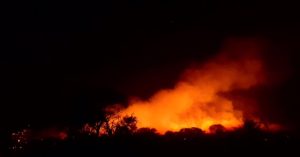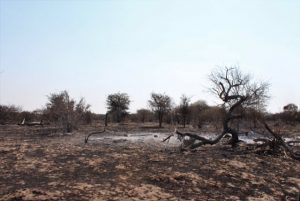
Meeting up at the Watering Hole – by Kate Evans 10 August 2017
August 10, 2017Scientists grapple with worms to improve co-existence with wildlife in Africa
January 29, 2018The Makgadikgadi Pans National Park Burns – Dr Rebecca Dannock 31st August 2017
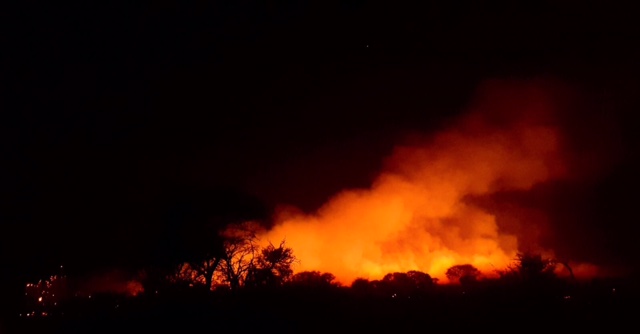
Fire in the park on Friday night
It has been less than a month since I took charge at EfA’s Makgadikgadi Research Camp but there has certainly been excitement. First, two leopards decided to hang out, not 5m from Hayley’s (our Scientific Officer’s), tent one night. Upon seeing them she called me out to lend extra torchlight and guide her back to my tent, where we sat for nearly two hours. Waiting. Eventually, we heard the leopards’ calls moving further off. So, with anxious steps, we crept outside to find the coast was clear and Hayley could go to her tent. An impromptu sleepover was avoided. But the next night was even more exciting*.
*for lack of a better word
On Friday, August 25th, Makgadikgadi started to burn. This was thanks to a combination of tinder box-like
conditions and tourists who claim their car was sparking, an unlikely story, but the only one we’ve got. At 2pm the fire started 800m from our camp. By 5pm more tourists, the DISS (the Directorate of Intelligence Security Services, who were called in to help fight the fire), DWNP (the Department of National Parks and Wildlife), SKL (the local campsite operator) and EfA were on the scene. By this point, the fire was out of control, and still just 500m from the tourist camp site. But it was moving northeast, directly away from all infrastructure, including our camp, so things seemed ok. Despite this, I organised for the EfA team to pack the car and then spend the night rotating watch to make sure we were ready to evacuate at a moment’s notice. By 3.30am, during my watch, the fire had died down and moved far from camp and danger seemed to have passed, at least for the time being. But being August, the month of strong winds in the Makgadikgadi, the fire had picked up again by morning. Danger still seemed remote, with the fire still moving north, but any chance of danger was not worth taking. So, I made the call to evacuate EfA.
Driving to Maun I felt a little bit silly. An overreaction, I thought. But within 35 minutes of leaving, reports came through that the fire had turned and was heading straight for camp. At which point I realised how poor my packing was – I’d only packed to spend a few days away from camp (dresses, travel toiletries, some shoes and pyjamas) with a couple of vital items of equipment (hard drives, laptops, tents, cameras and petrol that may have exploded if left behind). Having thought camp wouldn’t burn and having no sleep the night prior, my packing was substandard. But to be honest, no matter what we packed it wouldn’t have been enough – 5 people in one car didn’t leave a lot of room for all of our earthly belongings! We did, however, have the whole team safely out of the fire’s reach.
By the time we got to Maun, the fire had been through camp twice and the SKL staff, that had stayed behind, also decided to evacuate. But unfortunately, by the time they evacuated, one of their cottages had been burnt and two of their buildings were destroyed, as fire brought down their roofs and turned the buildings to rubble. Their kitchen and dining room were destroyed – all they could salvage was the fridge and a gas bottle. Yet, despite all this, and their pending evacuation, they continued to call me with updates and pick up the phone when I called. What troopers. By this point, I was starting to realise just how lucky I was to have chosen to evacuate the team. By Saturday evening, SKL had left the Park and so we were left without updates until it was safe to re-enter on Tuesday. It was a tense few days as we waited, unknowing. We swayed between denial (it’s fine, our camp may have been missed) and trying to make light of the situation (at least the mouse plague should have been dealt with!). But deep down the anxiety was building. While we were safe and had a small bag of belongings each, the thought of our lives and camp being destroyed played on our minds. Perhaps our safety, and reports that no-one (or at least no human) had been harmed allowed us to think about more trivial matters – homes, furniture, clothes and equipment (and in my case, a newly replenished stash of food from Australia!). But there was nothing to do but wait.
The drive back to camp on Tuesday (which was only 2 hours) seemed to be one of the longest drives of our 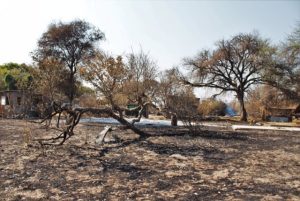 lives, excluding the drive out which was full of dire updates about what we had left behind us. The ferry across the Boteti, to get into the Park, seemed to be going backwards. And my stomach was in knots. As we drove from the gate to our camp we saw destruction on either side of the road for kilometres. The silence was palpable. I felt like I was living a news cast of an ‘aftermath’ special. As we entered camp we saw the destroyed buildings of SKL and the blackened earth between our still standing office and where our tents would hopefully be. It wasn’t a great welcome home.
lives, excluding the drive out which was full of dire updates about what we had left behind us. The ferry across the Boteti, to get into the Park, seemed to be going backwards. And my stomach was in knots. As we drove from the gate to our camp we saw destruction on either side of the road for kilometres. The silence was palpable. I felt like I was living a news cast of an ‘aftermath’ special. As we entered camp we saw the destroyed buildings of SKL and the blackened earth between our still standing office and where our tents would hopefully be. It wasn’t a great welcome home.
First, we saw our store cage that had been burnt- the frame damaged, the rear jump seats from our cars burnt, and spare tyres melted. But the cage was still standing. From there, instead of moving as individuals to our tents, we moved as a group with each person breaking off as we got to, and surveyed, their tents. The first stop was our newly renovated shower. Still perfect. Then we came across the supplies for the community and school chilli plots that we were about to build. Unfortunately, we lost a number of gum poles and mopane poles and will need to replace these so that we can continue 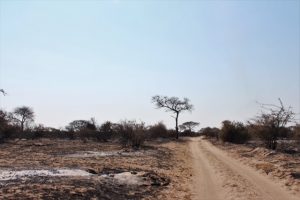 building chilli plots to promote self-reliance amongst the community.
building chilli plots to promote self-reliance amongst the community.
Then we got to the tents. Our research assistant’s tent was perfect, if a little smoky. Then our store tent – half fallen down but only because the ropes that held it up had burned away. The tent itself had no fire damage. The visitors’ tent – fine (still mouse ridden, but not fire affected!). But, the next two tents were worse for wear and unfortunately, both were only a month old. Their windows, made of a plastic-based gauze had melted. Some have shrunk as though the tent has been through a shrink wrapper, and others had melted away completely. But despite a couple of old mattresses becoming unusable and a smoky aroma clinging to everything, all personal belongings were safe! The next tent was the worst though. The shade netting was destroyed, the charging solar lantern had melted into a non-working mess, one window was gone and the other had shrunk into half its original size, scrunching the whole tent into a twisted mess. And the roof was shredded from falling embers. But still, no damage inside. We went to another tent and found more missing windows. But still no loss of items inside. The final tent was untouched by fire but full of smoke.
So, we were down 4 of our 7 accommodation tents. And everything we own has the stench of smoke clinging to it. However, considering we thought we’d lost everything, we were lucky. Mostly because we had recently employed someone to slash the grass around the tents, in what we thought would keep us safe from snakes, more than fire. The slasher finished this job 1hr before we heard about the fire! This gave us enough of a barrier around the tents to largely protect them. Talk about timing.
We were all shaken, and we need to find funds to replace four tents and burnt building supplies but I am glad to report that we are all safe and so is our data! And the show must go on – so shortly after checking our home, we piled back into the car to stay on the community side for a week to put on a documentary night for the community and conduct workshops across the cattle posts to teach the farmers about how to use chilli to deter elephants.
If you are able to donate to help us restore our camp to full working order and please visit https://mydonate.bt.com/events/emergencyfirefund
Thanks to a long term Elephants for Africa supporter, every £ donated will be matched.
To view our video about the fire click here

